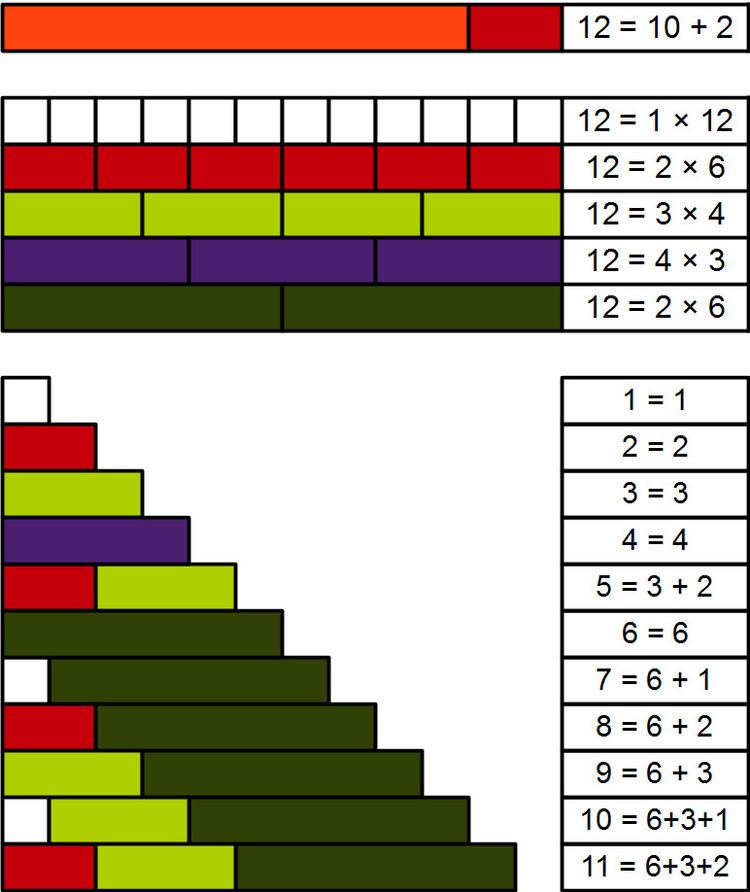 | ||
In number theory, a practical number or panarithmic number is a positive integer n such that all smaller positive integers can be represented as sums of distinct divisors of n. For example, 12 is a practical number because all the numbers from 1 to 11 can be expressed as sums of its divisors 1, 2, 3, 4, and 6: as well as these divisors themselves, we have 5 = 3 + 2, 7 = 6 + 1, 8 = 6 + 2, 9 = 6 + 3, 10 = 6 + 3 + 1, and 11 = 6 + 3 + 2.
Contents
- Characterization of practical numbers
- Properties
- Relation to other classes of numbers
- Practical numbers and Egyptian fractions
- Analogies with prime numbers
- References
The sequence of practical numbers (sequence A005153 in the OEIS) begins
1, 2, 4, 6, 8, 12, 16, 18, 20, 24, 28, 30, 32, 36, 40, 42, 48, 54, 56, 60, 64, 66, 72, 78, 80, 84, 88, 90, 96, 100, 104, 108, 112, 120, 126, 128, 132, 140, 144, 150....Practical numbers were used by Fibonacci in his Liber Abaci (1202) in connection with the problem of representing rational numbers as Egyptian fractions. Fibonacci does not formally define practical numbers, but he gives a table of Egyptian fraction expansions for fractions with practical denominators.
The name "practical number" is due to Srinivasan (1948). He noted that the subdivision of money, weights and measures involved numbers like 4, 12, 16, 20 and 28 which are usually supposed to be so inconvenient as to deserve replacement by powers of 10. He rediscovered the number theoretical property of such numbers and was the first to attempt a classification of these numbers that was completed by Stewart (1954) and Sierpiński (1955). This characterization makes it possible to determine whether a number is practical by examining its prime factorization. Every even perfect number and every power of two is also a practical number.
Practical numbers have also been shown to be analogous with prime numbers in many of their properties.
Characterization of practical numbers
The original characterisation by Srinivasan (1948) stated that a practical number cannot be a deficient number, that is one of which the sum of all divisors (including 1 and itself) is less than twice the number unless the deficiency is one. If the ordered set of all divisors of the practical number
In other words the ordered sequence of all divisors
This partial characterization was extended and completed by Stewart (1954) and Sierpiński (1955) who showed that it is straightforward to determine whether a number is practical from its prime factorization. A positive integer greater than one with prime factorization
where
The condition stated above is necessary and sufficient for a number to be practical. In one direction, this condition is necessary in order to be able to represent
Properties
Relation to other classes of numbers
Several other notable sets of integers consist only of practical numbers:
Practical numbers and Egyptian fractions
If n is practical, then any rational number of the form m/n may be represented as a sum ∑di/n where each di is a distinct divisor of n. Each term in this sum simplifies to a unit fraction, so such a sum provides a representation of m/n as an Egyptian fraction. For instance,
Fibonacci, in his 1202 book Liber Abaci lists several methods for finding Egyptian fraction representations of a rational number. Of these, the first is to test whether the number is itself already a unit fraction, but the second is to search for a representation of the numerator as a sum of divisors of the denominator, as described above. This method is only guaranteed to succeed for denominators that are practical. Fibonacci provides tables of these representations for fractions having as denominators the practical numbers 6, 8, 12, 20, 24, 60, and 100.
Vose (1985) showed that every number x/y has an Egyptian fraction representation with
According to a September 2015 conjecture by Zhi-Wei Sun, every positive rational number has an Egyptian fraction representation in which every denominator is a practical number. There is a proof for the conjecture on David Eppstein's blog.
Analogies with prime numbers
One reason for interest in practical numbers is that many of their properties are similar to properties of the prime numbers. Indeed, theorems analogous to Goldbach's conjecture and the twin prime conjecture are known for practical numbers: every positive even integer is the sum of two practical numbers, and there exist infinitely many triples of practical numbers x − 2, x, x + 2. Melfi also showed that there are infinitely many practical Fibonacci numbers (sequence A124105 in the OEIS); the analogous question of the existence of infinitely many Fibonacci primes is open. Hausman & Shapiro (1984) showed that there always exists a practical number in the interval [x2,(x + 1)2] for any positive real x, a result analogous to Legendre's conjecture for primes.
Let p(x) count how many practical numbers are at most x. Margenstern (1991) conjectured that p(x) is asymptotic to cx/log x for some constant c, a formula which resembles the prime number theorem, strengthening the earlier claim of Erdős & Loxton (1979) that the practical numbers have density zero in the integers. Saias (1997) proved that for suitable constants c1 and c2:
Finally Weingartner (2015) proved Margenstern's conjecture showing that
for
